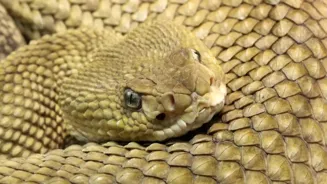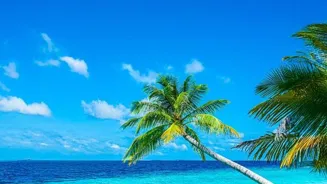Snake Island. The very sound of it is enough to send shivers down your spine. You don’t need to be a zoologist, an adventurer, or even someone with a wild
imagination to know that this is not your average beach holiday destination. Officially known as Ilha da Queimada Grande, this rocky speck in the Atlantic Ocean lies about 33 kilometres off the coast of São Paulo, Brazil. At first look, it may appear like a lush, tropical paradise with green forest cover and beautiful sea views straight out of a postcard. But beneath this beauty lurks one of nature’s deadliest secrets — a hissing, slithering population of snakes so venomous that setting foot here could be the last thing you ever do. The legend of Snake Island is not just about danger but it is about secrecy, evolution, and a location so forbidden that even locals avoid looking at it for too long. The question is - Do people really live here? Could anyone survive in this nightmare of scales and fangs? Let’s unravel the truth.
The Golden Lancehead: Nature’s Ruthless Assassin
The protagonist or rather villain of Snake Island is the golden lancehead pit viper (Bothrops insularis), a species found nowhere else in the world. You read that right! There are an estimated 2,000 to 4,000 of them slithering across just 43 hectares of land, which means the maths is not in your favour. Some locals even whisper that there’s at least one snake lurking in every square metre of the island. Scientists argue the numbers may not be that high, but either way, it’s not the kind of neighbourhood you’d want to move into.
Their venom is five times more potent than that of their mainland cousins. A single bite can cause rapid internal bleeding, kidney failure, tissue death, and stroke. Death is not just possible; it’s almost guaranteed without immediate treatment. Credit goes to evolutionary isolation—the island was cut off from the mainland about 11,000 years ago, forcing the snakes to adapt. With no rodents around, they learned to hunt migratory birds, developing venom so fast-acting it could kill prey before they managed to fly away.
Could Humans Live Here? Spoiler Alert: Absolutely Not
By now, the answer is obvious: no human permanently lives on Snake Island. And it’s not just because no one is brave—or foolish—enough to try. The Brazilian Government has made it illegal to step foot on the island without authorisation. The reasoning is two-fold: to protect human life from accidental death, and to protect the endangered golden lancehead from curious visitors and smugglers.
There is one tiny exception to this rule: the Brazilian Navy. Once or twice a year, Navy personnel sail to the island to maintain the lighthouse, which now runs automatically. And even then, they are armed with strict safety protocols. Imagine visiting a place where you have to watch your every step, not because you might trip on a rock, but because a viper might be curled up just under it.
Legends of the Lighthouse Keeper
Of course, no place so mysterious is without its folklore. Locals tell an old story about the island’s last human residents—a lighthouse keeper and his family. According to the tale, the family met a gruesome end when snakes managed to slither in through the windows and doors. Some stories say they tried to flee, only to be attacked before reaching their boat. If true or not, this scary and chilling legend only fuels the island’s reputation as one of the most terrifying places on Earth.
The Forbidden Island and Its Ecological Value
Snake Island is immensely important ecologically. The snake species, golden lancehead, is critically endangered, and the island is its only natural habitat. The vipers rely on migratory birds for food, turning Snake Island into an accidental pit stop for winged travellers that don’t know what they’re flying into.
Conservationists argue that protecting the island is vital—not just for the snakes, but for biodiversity at large. Credit goes to the Instituto Chico Mendes de Conservação da Biodiversidade (ICMBio) in Brazil, which oversees conservation policies. The balance is fragile: mainland deforestation is reducing bird populations, which in turn threatens the snakes’ survival.
A Place Wrapped in Secrecy
Very few people have ever set foot on this island, mostly scientists under heavily controlled conditions. Wondering how they survive there? Well, the researchers often wear thick protective clothing, avoid walking in tall grass, move in groups. Even then, the sense of constant danger is enough to make the bravest biologist break into a cold sweat.
Smugglers have also put their lives at risk and have tried sneaking onto the island to capture snakes. For the unversed, a golden lancehead can get thousands of dollars on the black market cause of its venom and rarity. It is said that the venom can be used in several medical applications, including treatments for heart disease. But the risks are enormous, and most stories end in disaster rather than riches.
So, Do People Really Survive on Snake Island?
The truth is simple: people don’t live on Snake Island—and they can’t. The island belongs to the snakes, and it’s likely to stay that way. With its lethal vipers, forbidden access, and chilling legends, Snake Island stands as one of the rare places where nature has drawn an unmistakable boundary for humans.
It’s a paradox: a place too dangerous for us, yet too precious to ignore. The island serves as a reminder that some corners of the Earth are best left to wild things, guarded by fangs and venom, far away from curious footsteps.














